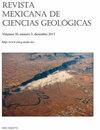Geology and geochemistry of jasperoids from the ‘Montaña de Manganeso’ district, San Luis Potosí, north-central Mexico
IF 0.5
4区 地球科学
Q4 GEOSCIENCES, MULTIDISCIPLINARY
Revista Mexicana De Ciencias Geologicas
Pub Date : 2021-11-24
DOI:10.22201/cgeo.20072902e.2021.3.1651
引用次数: 0
Abstract
Large outcrops of jasperoids occur in the ‘Montaña de Manganeso’ mining district in north-central Mexico. They range from massive manganiferous jasperoids to highly brecciated, hematitic jasperoid. The jasperoids of ‘Montaña de Manganeso’ occur mainly as replacements of limestone, sandstone and shale, commonly nearby high-angle fault systems. The mineralogy of the jasperoids consist of quartz and its polymorphs (chalcedony, tridymite and cristobalite), Fe-Mn oxyhydroxides, calcite and minor barite. Many outcrops show evidence of several periods of brecciation and silicification. The geochemical signature of the jasperoids suggests that silicification was product of hydrothermal activity. The jasperoids display enrichment in elements of hydrothermal provenance such as Ba, Sr, As, Cr, Mo, Sb, Ni, Zn and Cu, whereas are strongly depleted in the elements indicative of clastic sources such as Ti, K, Th and Zr. Element ratios such as (Fe+Mn)/Ti, Al/(Al+Fe+Mn), Fe/Mn and U /Th, along with the Al-Fe-Mn and Fe-Mn-(Ni+Co+Cu)×10 ternary diagrams confirm a hydrothermal origin. Low ∑REE, an enrichment of LREE over HREE, negative Ce anomalies and positive Y anomalies (YPASS/HoPAAS) also support the hydrothermal processes. The geological evidence, in the form of a feeder zone and extensive hydrothermal alteration, show that the silica forming the rocks originated from ascending hot fluids.墨西哥中北部圣路易斯Potosí ' Montaña de Manganeso '地区茉莉属植物的地质和地球化学
墨西哥中北部的“Montaña de Manganeso”矿区出现了大量的碧玉露头。它们的范围从巨大的含锰碧玉到高度角砾化的赤铁矿碧玉。“Montaña de Manganeso”的碧玉岩主要作为石灰岩、砂岩和页岩的替代物出现,通常位于高角度断层系统附近。碧玉的矿物学由石英及其多晶型(玉髓、鳞石英和方石英)、Fe-Mn氢氧化物、方解石和少量重晶石组成。许多露头显示出若干时期角砾岩和硅化的证据。碧玉的地球化学特征表明硅化作用是热液活动的产物。碧玉岩富含Ba、Sr、as、Cr、Mo、Sb、Ni、Zn和Cu等热液来源元素,而Ti、K、Th和Zr等碎屑来源元素则强烈贫化。元素比例,如(Fe+Mn)/Ti、Al/(Al+Fe+Tn)、Fe/Mn和U/Th,以及Al-Fe-Mn和Fe-Mn-(Ni+Co+Cu)×10三元图证实了水热成因。低∑REE、LREE比HREE富集、负Ce异常和正Y异常(YPASS/HoPAAS)也支持了热液过程。地质证据以补给带和广泛的热液蚀变的形式表明,形成岩石的二氧化硅来源于上升的热流体。
本文章由计算机程序翻译,如有差异,请以英文原文为准。
求助全文
约1分钟内获得全文
求助全文
来源期刊

Revista Mexicana De Ciencias Geologicas
地学-地球科学综合
CiteScore
1.00
自引率
12.50%
发文量
0
审稿时长
6-12 weeks
期刊介绍:
Revista Mexicana de Ciencias Geológicas (RMCG) publishes original research papers on geological processes of broad interest, and particularly those dealing with regions of Latin America. The RMCG also publishes review papers on topics of current interest, and on the geology and tectonics of geological provinces of Latin America. Besides, it offers the opportunity for host editors to publish special thematic issues.
 求助内容:
求助内容: 应助结果提醒方式:
应助结果提醒方式:


